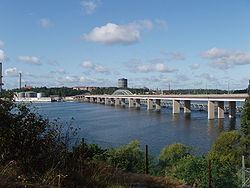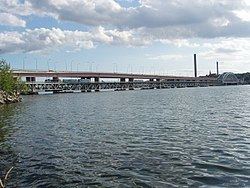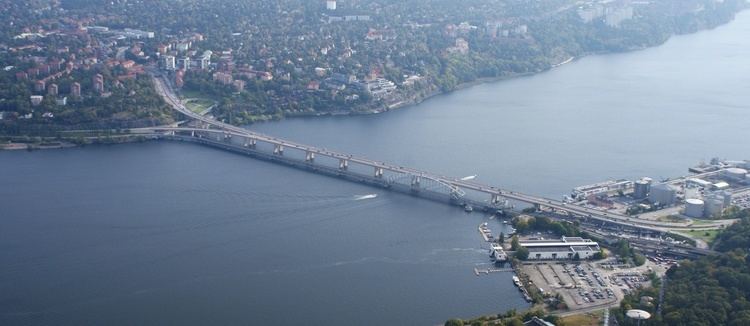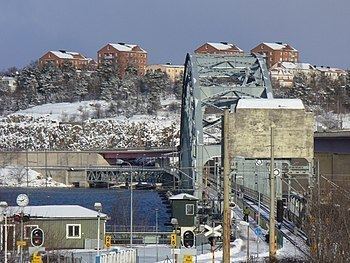 | ||
Liding banan linje 21 crossing gamla liding bron bridge
Lidingöbron (Swedish: "The Lidingö Bridge") is the name of two existing and two historical bridges across the strait of Lilla Värtan between the mainland Norra Djurgården at Ropsten, at the eastern part of Stockholm, and the island of Lidingö.
Contents
- Liding banan linje 21 crossing gamla liding bron bridge
- First pontoon bridge
- Second pontoon bridge
- Old Lidingbron
- New Lidingbron
- References

First pontoon bridge

At a parish meeting in 1802, the inhabitants of Lidingö, at the time a mostly agricultural district, decided to open a venture to realize a pontoon bridge connecting the island to Stockholm. The 50 shares of the company had to be redeemed by contributing to the project with timber, work, or money and the bridge was completed in 1803; almost 800 metres long, 7 metres wide and financed by tolls. It was one of the longest bridges in Europe, and it was located around 2 km south of the present bridges. It had a hard time surviving the annual ice break-up, and a third of it was demolished in 1811, and most of it in 1858 — each time raising the price for milk in the capital, as most of it was produced on Lidingö at the time.
Second pontoon bridge

With the creation of the harbour of Värtan, the original bridge obstructed shipping in the strait, and it was therefore bought by the city of Stockholm in 1883 who replaced it 1884 with a new pontoon bridge, 12 metres wide and with two moveable sections at each end for the passage of ships. This bridge was located near the present bridge. The level of the roadway was only 10–15 cm over the water surface however, so even moderate winds made crossing the bridge a tough experience. The lateral stability of the bridge was ensured by means of logs attached to the bridge every 24 metres and anchored to the bottom. The use of logs instead of chains effectively increased the bridge's general buoyancy at the cost of its stability during low tide - the bridge often serpentined its way across the water while the inclination of the roadway at the two ends made use of extra horses necessary. Heavy trucks started to use the bridge, for which it was not constructed. Ice break-up destroyed a third of the bridge in 1918.
Old Lidingöbron

By the end of World War I, the increasing number of motor cars made a more able bridge necessary, and by 1925 a steel truss bridge, 9.1 metres wide with a 6.7-metre roadway, finally replaced the second pontoon bridge. It had two railway tracks in the same carriageway as the road.

To avoid foundation work at the maximum depth a 140-metre-long truss arch was used, and to allow a horizontal clearance of 5.3 metres for boats the bridge was provided with a simple 20-metre-long bascule leaf.

After the new bridge was built, cars were no longer allowed on the old bridge. It has one rail track which is now considered a tramway (or light rail line), the Lidingöbanan. The other half of the bridge is used for bicycles and pedestrians.
New Lidingöbron
The population of Lidingö as well as the traffic continued to grow however, and by the 1950s the old bridge had become insufficient. The two municipalities met in 1961, and the following year it was settled a new bridge should be located south of the old. The new bridge, inaugurated in 1971, is 997 metres long, 24 metres wide, and offers a horizontal clearance of 12.5 metres while the roadway passes 75 metres above the bottom of the strait. The part of the bridge passing over water, 724 metres long, is made of double box girders with a maximum span of 73.5 metres, the entire construction resting on steel poles filled with concrete.
